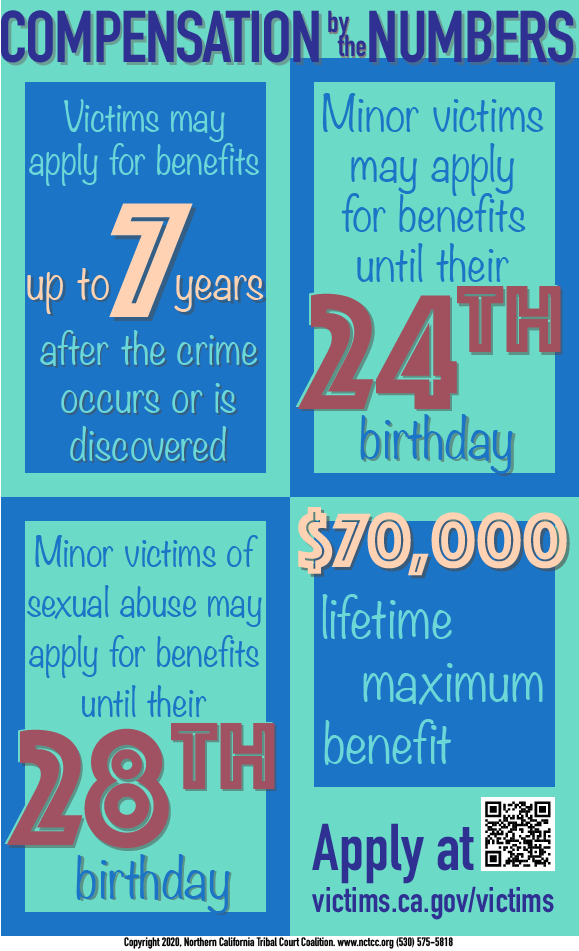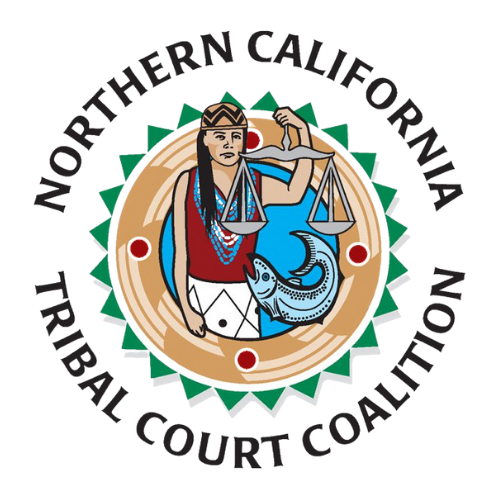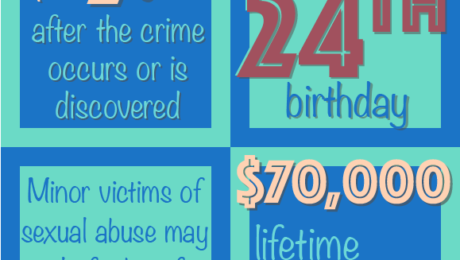An Overview of California Victims’ Compensation
The California Victim Compensation Board (CalVCB) provides compensation for victims of violent crime, including victims of domestic violence and DUI crimes. This article is the first in a multi-part series about CalVCB for Domestic Violence (DV) advocates, DV victims, their families, and their communities. This article focuses on domestic violence victims. However, please keep in mind that benefits are available to victims of any violent crime.
Tribal victims of domestic violence often face more obstacles and greater difficulty overcoming the obstacles than non-tribal victims. CalVCB is a state agency that connects victims of violent crime with financial assistance. While financial assistance does not eliminate all the difficulties that confront DV victims, economic assistance can help minimize the obstacles that victims encounter. In this way, CalVCB is a resource that can help victims achieve positive outcomes.
PART 1: An Overview of California Victim Compensation
Victims of violent crime and their family members can apply for financial compensation for physical injury, threatened physical injury, emotional trauma, and psychological trauma. You have up to seven years after the crime was committed or discovered to apply for financial benefits. DV Advocates can help you apply for CalVCB compensation, or you can appoint a representative to assist with filing your application. Even if you think you do not need compensation right now, you should consider submitting an application so that future complications and out of pocket expenses can be compensated.
Find more information here.
Qualifying crimes
A crime is considered “violent” if it involves physical injury, threat of physical injury, psychological trauma, or emotional trauma. If you have experienced any of these types of violence, you may qualify for compensation. The following list of crimes are those that CalVCB typically covers.
- Domestic violence
- Child abuse
- Child sexual assault
- Child endangerment and abandonment
- Assault with a deadly weapon
- Battery (when there is injury or threat of injury)
- Driving under the influence
- Elder abuse
- Hate crimes
- Homicide
- Human trafficking
- Hit and run
- Vehicular manslaughter
- Murder
- Robbery
- Sexual assault
- Stalking
- Sexual battery
- Unlawful sexual intercourse (where there is injury or threat of injury)
- Terrorism
- Online harassment
- Other crimes that result in physical injury or a threat of physical injury to the victim
If you or a family member has been a victim of a crime that is not on this list but suffered physical injury, threat of physical injury, or emotional trauma as a direct result, you may qualify for benefits. If you have a question about whether a crime qualifies for compensation, you may call the CalVCB helpline at (800) 777-9229 or email at info@victims.ca.gov.
Find more information here.
Qualifying applicants
Applicants who may apply for compensation include:
- Direct victims of violent crime, including minor children.
- The family members and individuals who have or had close, intimate relationships with victims.
- Children who witness violent crime.
- Applicants must not have been involved in or committed a felony in the events leading to the crime.
Find more information here.
Qualifying expenses
CalVCB covers expenses that are directly related to the violent crime that caused your injury. Typical expenses include:
- Medical and dental treatment
- Mental health care including Telehealth
- Complementary and alternative medicine
- Funeral/burial expenses
- Medically necessary equipment
- Home or vehicle modifications
- Home security
- Relocation (moving) expenses
Find more information here.
- Income loss for direct victims and for parents/legal guardians of a minor who is hospitalized or dies
- Support loss for victims’ legal dependents
- Job retraining
- Crime scene clean-up
- Benefits for good samaritans
- Guide, signal, or service dogs
Qualifying application period
To qualify for CalVCB benefits, you must apply before the time limit has passed. Beginning in January 2020 the time limit for submitting an application has been increased from three to seven years. In some circumstances the application deadline can be extended.
For minor victims, a different time limit applies. Minor victims may apply any time before their 24th birthday. For minor victims of sexual abuse, the deadline to apply is the victim’s 28th birthday.
Find more information here.

Documentation needed for your application
To document that you are a victim of a violent crime, you should expect to provide a law enforcement report or other verification. This can include a crime report, child or adult protective services report, copy of a petition for a restraining order (an order signed by a judge does not contains insufficient information; you will need to show the petition), medical and/or mental health records, affidavit from a human trafficking case worker, sexual assault examination report, Title IX campus report, battered women’s program paperwork, or a credible witness statement. Other documentation is evaluated on a case-by-case basis.
To document your expenses, you can expect to provide CalVCB with copies of crime-related bills, receipts, insurance, medical costs, mileage records, lost wages, funeral costs, relocation expenses (Lease Agreement, CalVCB Rental Verification Form, or Landlord’s W-9 Form) and any other expenses directly related to the crime.
To show other potential sources of coverage, you should expect CalVCB to ask you for insurance policy information and any other resources that can be used to pay your crime-related expenses.
Find more information about reimbursable expenses here.
Victims can apply online, however, accessing the application form prior to filing online can help you anticipate the information you will need to provide. PDF versions of the application are available in English, Spanish, or another language.
Learn more about qualifying for CalVCB benefits
CalVCB offers e-learning courses for victims of crime, family and friends of victims, the general public, service providers, helping professionals, advocates, and law enforcement. You can access training at victims.ca.gov/training/ and learn more about CalVCB here.
Assistance for tribal members
CalVCB has several ways in which it can assist tribal members who are victims of violent crime, including domestic violence.
First, tribal members are classified as California residents for eligibility determination purposes, even when the victim is a resident of a Reservation or Rancheria in California. Because tribal members are considered California residents they are eligible for compensation wherever the crime was committed. Also, for the purpose of determining whether a crime was committed in California, if a crime occurs in a California tribe’s jurisdiction, it is committed “inside California.” This eliminates the jurisdictional barrier some victims would otherwise encounter.
Second, CalVCB attempts to provide culturally sensitive services to tribal members. This means that tribal victims can receive reimbursement for a wide range of crime-related expenses including those that may be incurred to support a tribal victim’s lifeways. For instance, in addition to expenses such as medical costs, mental health treatment, relocation expenses, and loss of income CalVCB may also reimburse ceremonial costs, complementary and alternative medicine services, and in some cases can provide emergency financial assistance within 30 days.
Find information about CalVCB services for tribal communities here.
How to apply
Victims of domestic violence are eligible for CalVCB benefits because domestic violence is, by definition, a crime of violence. When a tribal member is victimized, applying for benefits to cover financial expenses can make the difference and help the healing begin.
You can apply for benefits using the CalVCB online application form or download a printable form here.
In Part 2 we will take a closer look at the CalVCB application.
Find a Victim Advocate and other resources with the NCTCC App
You can find a Victim Advocate, community organization, and other helpful resources using NCTCC’s mobile App. Download the App here.

Do you need assistance with downloading or using the NCTCC App? Reach out to us for technical assistance, to arrange a training, or ask questions about this article. Our Program Specialists are here to help. Contact Cynthia Boshell at cboshell@nctcc.org or Jake Swamp at jswamp@nctcc.org.
- Published in Uncategorized
3 vital ways advocates help tribal victims of violent crime
Tribal members who live on reservations are already vulnerable to violent crime due to the inconsistencies of law enforcement in Indian Country. Enforcement can be the responsibility of federal, state, or tribal jurisdictions depending on where the crime occurred. This creates victim uncertainty about how to report a crime and the extent of their rights. In this situation obtaining assistance with the legal process can be especially helpful. Victim advocates can be a lifeline for victims because advocates have the knowledge, skill and ability to contribute meaningful expertise, especially during times of crisis. Here are 3 important ways advocates can help tribal victims of violent crime.
1. Victim Advocates can shield crime victims from further traumatization by functioning as buffers.
Victim advocates are liaisions between law enforcement and victims. Advocates can transform what could otherwise be an intrusive process into a positive, trauma-centered victim support. Advocates can minimize the physical, emotional, and psychological pain that results from reliving a crime. Often victim advocates can respond on behalf of victims or summarize law enforcement requests to victims in order to prevent further distress during trauma recovery. Advocates have the ability to work with victims to reduce the stress of investigation and prosecution.
2. Victim advocates use their justice system expertise to help victims navigate the reporting process.
Advocates provide a shoulder for victims to lean on throughout the process. Advocates educate victims about their legal rights and the legal process, accompany victims to court, help victims with reporting and questioning, assist victims with completing paperwork, and can help victims with finding an attorney.
3. Victim Advocates help victims get reimbursement for crime-related expenses.
Victim advocates can assist victims with completing applications for financial compensation. When victims have insurance plans, advocates can help victims apply for the benefits they deserve. When expenses are not covered by private insurance, victim advocates can help victims obtain state compensation to cover expenses directly related to their physical and emotional injuries. Advocates can also provide information about statutory deadlines and family member compensation.
If you are a tribal member who has experienced a violent crime, you can ask a victim advocate to help you navigate tribal, state and federal justice systems. Download the NCTCC App to find victim service organizations near you.
If you are a Victim Advocate looking for ways to better serve your clients the NCTCC App can connect you with resources. Our Project Specialists can provide remote, one-on-one or group training on the App. Contact Cynthia Boshell (cboshell@nctcc.org) or Jake Swamp (jswamp@nctcc.org) to arrange a training.
- Published in Uncategorized

